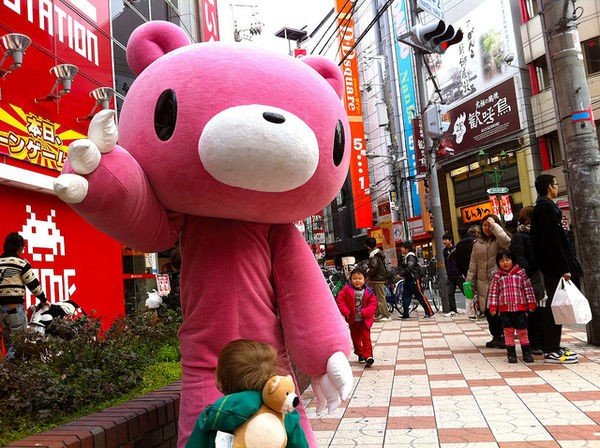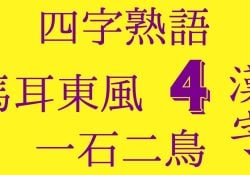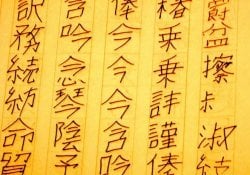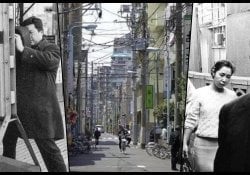Many imagine that the main way to say goodbye in Japanese is sayonara. This is a big mistake! The Japanese don't use sayonara daily! In this article, we will understand the true meaning of sayonara and 50 other ways to say goodbye in Japanese.
Sayounara [さよなら] literally means goodbye, but we only usually say goodbye when we are going to go a long time without seeing the person. So, it's not common for Japanese people to be saying Goodbye everywhere when you say goodbye.
Suppose you are at work and you say Goodbye to the boss, he'll think you're quitting your job. There are thousands of ways the Japanese use to say goodbye properly, and in this article we are going to examine them.
Before, let's study in detail the meaning of sayonara and its origin. If you want to jump to the ways to say goodbye in Japanese, let's leave a summary of the article below:
Índice de Conteúdo
Sayonara x Sayounara
Before we examine the deeper meaning and usage of sayonara, we must answer a question that may confuse students of Japanese. What is the right way to write? Goodbye [さよなら] or Sayounara [さようなら]?
If you have studied Japanese for a long time, you must be thinking that the correct form is Goodbye [さようなら] and Brazilians write sayonara deceived because of a type of romanization which represents the hiragana"OU" [おう], which is a ō accented [sayōnara].

This happens mainly because in words with "OU"[おう] the sound of "U” [う] is often hidden. But in Japanese, both forms, sayonara and sayounara, are correct!
These two words are used in Japanese language, both mean goodbye, but have slight differences. In the next topic, we will explain the origin and meaning of sayonara, so you will be able to understand the differences between sayounara and sayonara.
The meaning of the word Sayonara
The word sayonara [さよなら] originated from the expression Sayounaraba [左様ならば] where:
- Sayou [左様] means: "in that way"; "therefore"; "everything was discussed" and "done";
- Naraba [ならば] - Auxiliary that conveys the idea of "then; that being the case; if circumstances permit; if; in case; if it is" and things like that;
- Sayounara [左様なら] - Well, if that's how it is... If things are going to be like that...
Thus we come to the conclusion that Goodbye [左様なら] is the correct spelling. But nowadays things have changed and the Japanese tend to write sayonara [さよなら], which can even be used as a suru verb and noun.

Although some say that sayonara [さよなら] just means goodbye, it can indicate a farewell and many other things in the Japanese language. See some words below to understand their meanings:
- Sayonara Paatii [さよならパーティー ] – Farewell Party;
- Seishun ni sayonara suru [青春にさよならする] – Say goodbye to youth;
The first sentence shows that sayonara can be used to express farewell or the end of something. While the following sentence shows that sayonara can be used as a suru verb.
Although some imagine that sayonara it is rare to be used, students from elementary school are oriented to use these words to say goodbye to the teacher. in many regions sayonara is still used without a long period of absence.
Jyaa ne e Mata ne - See you later in Japanese
The main and best alternative to saying goodbye in Japanese is the words jyaa ne [じゃね], kill it [またね] and its countless variations. These words are equivalent to the traditional Portuguese bye, flw or see you soon.
See below for a large number of variations derived from Woods and jyaa that will increase your vocabulary:
- Jyaa [じゃあ] - Until;
- Jyaa ne [じゃあね] - See you later;
- Mata ne [またね] - See you later;
- Jyaa mata[じゃあまた] - See you later;
- Mata ato de [また後で] - See you later;
- Mata kondo [また今度] - See you soon;
- Mata ashita [また明日] - See you tomorrow;
- Mata raishu [また来週] - See you next week;
- Mata Raigetsu [また来月] - See you next month;
- Mara rainen [また来年] - Until next year;
- Dewa mata [ではまた] - See you later;
- Mata aou [また会おう] – Until we meet again;
- Sorejyaa, mata ne [それじゃ] - So, see you later!

The ways to say goodbye listed above are a bit informal. Notice how many variations of goodbye there are in Japanese. The word jyaa [じゃあ] means literally "then, so, then; While" Woods [また] means again, as well as, and also;
Young people often use this way of saying goodbye in Japanese a lot. These are undoubtedly the best ways, but there are many others that we are going to see, some specific to each occasion. You can also create your own variations with the words we saw in the list above.
The article is still halfway through, but we recommend also reading:
Ittekimasu and itterashai - farewell when leaving home
When you're out of your house you can say ittekimasu [行ってきます], when someone from your house is going to come out and say ittekimasu, you can say itterashai [行ってらしゃい].
I'm off/I'm leaving and Itterashai are used indoors when someone leaves or returns, is like saying: I'm leaving, and the person of the house replies: Go in peace / Go your way well, be careful, come back soon...

Just as we say "take care" in Portuguese as a way of saying goodbye, you can also say ki wo tsukete [気をつけて] in Japanese. You can say this to someone who is leaving their home, or going somewhere not far away.
It has nothing to do with the article, but it is worth remembering that when you get home, the person says tadaima [ただいま] which means I arrived, while the person in the house says okaeri [おかえり] which means welcome.
SAYING GOODBYE AT WORK IN JAPANESE
In Japan, many people work overtime, so when you are leaving work, always some will continue working. You should politely say goodbye saying: Osaki ni shitsurei shimasu [お先に失礼します] which means "I'm sorry I had to leave first/earlier".
You can also say in abbreviated form osakini [お先に] to your colleagues, but you cannot use this informality with your boss. You can also use alone shitsurei shimasu [失礼します] which is also equivalent to an excuse.

When someone is leaving work and says o saki ni shitsureishimasu [お先に失礼します], you can reply otsukaresama deshita [お疲れ様でした] which translates to something like "Thank you for your hard work."
Another similar phrase you might hear is: gokurousama deshita [御苦労様でした]. Its meaning is similar to otsukaresama deshita, but it is said for people of a lower level. For example, a boss might say this to his team.
Other Ways to Say Goodbye in Japanese
genki of [元気で] – If someone is going on a long trip or is going to move to a different place and you won't see them for a long time, you can say Good luck! [元気で] which is like saying "take care of yourself","be alright" or " all the best."
Odaiji ni [お大事に] - If you are saying goodbye to someone who is sick, you can say odaiji ni [お大事に], which means "get well soon".
Saraba da [さらばだ] – A very old expression (used by samurai) to say goodbye. Perhaps, the closest equivalent of “adios!” Therefore, it cannot be used in a formal way, only with your close friends or in jest.

Oyasuminasai [おやすみなさい] – Means good night, but can be used to say goodbye to someone who is going to sleep or if you are leaving their house at night.
Gochisou sama deshita [ご馳走様でした] – It is used to thank food in restaurants, but it can be a farewell to a restaurant when paying the cashier for example.
- Mata miruyo [また見るよ] – See you soon;
- Mata oaishimashou [またお会いしましょう] – Let's meet again;
- Mata renraku shimasu [また連絡します] – I will contact you;
Foreign ways to say goodbye in Japanese
One of the most popular and used foreign forms in Japan comes from the English Bye Bye. Many young Japanese people often use baibai [バイバイ] to say goodbye informally to friends and other people. Sometimes this expression can sound a little feminine.
The Japanese also know the traditional Spanish and Castilian adios. In Japanese this expression is written goodbye [アディオス]. There is also a variation of written French goodbye [アデュー].
Ways to say goodbye in different dialects of Japan
To finish off the goodbyes in Japanese, let's share how to say sayonara, jyane or other words that we saw throughout the article in different regions of japan.
Responsive Table: Scroll the table sideways with your finger >>
| word in dialect | Province | Standard |
| Njichaabira [んじちゃーびら] | Okinawa | farewell |
| Soregii [そいぎー]; | Saga | それじゃあ |
| Guburiisabira [ぐぶりーさびら] | Okinawa | farewell |
| omyo-nichi [おみょーにち]、 | Iwate | また明日 |
| omyounudzu [おみょうぬづ] | Iwate | また明日 |
| irashiteoideasobase [いらしておいであそばせ] | Ishikawa | farewell |
| aba [あば] abaaba [あばあば] | Gifu | farewell |
| oina-yo [おいなーよ] | Wakayama | またおいでよね |
| soiginta [そいぎんた] | Saga | farewell |
| abana [あばな] | Nagano | farewell |
| abana [あばな] | Nagano | farewell |
| oshizukani [おしずかに] | Ishikawa | farewell |
| omicho [おみちょ] | Niigata | farewell |
| omichiyo- [おみちよー] | Niigata | farewell |
| omyonudzu [おみょうぬづ] | Iwate | farewell |
| omyo-nichi [おみょーにち] | Iwate | farewell |
| ndakkyaane [んだっきゃあね] | Aomori | farewell |
| seba [せば] heba [へば] | Aomori | farewell |
There are still thousands of other ways to say goodbye in Japanese, in addition to regional variations of sayonara, if you remember any you can leave them in the comments. I hope you enjoyed the article, if you did, share it with your friends and leave your comments.







